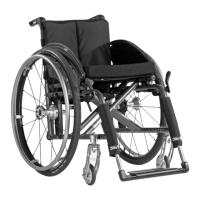90
76
77
6.11 Mounting the Anti-tipper (Fig. 78–81)
1.
Mount the receiver tube with the two screws (Fig. 78, item 1) on the inner side of the posterior
frame part. Tighten the nuts (Fig. 78, item 2) with a torque of.
2.
Insert the expansion spring (Fig. 79, item 4) with the close eyelet into the receiver tube. When
the receiver tube's bore hole and the eyelet hole are ush, insert the sleeve (Fig. 79, item 3).
Secure the sleeve with the screw (Fig. 80, item 7). Tighten the nut (Fig. 80, item 8) with a
torque of.
3.
Hook a cord (Fig. 80, item 10) into the lower eyelet of the expansion spring and push the
anti-tipper tube (Fig. 79, item 6) over the cord and expansion spring into the receiver tube.
4. Pull at the cord (Fig. 80, item 10) until the expansion spring extends from the anti-tipper tube
(Fig. 79, item 6).
5. Secure the expansion spring using a screwdriver (Fig. 81, item 11) and remove the cord. Put
the spring holder (Fig. 81, item 12) onto the lower eyelet of the expansion spring. Remove the
screwdriver. The eyelet of the expansion spring will then snap into place.
The anti-tipper can now be adjusted to the position of your rear wheel. After the screw connec-
tion has been loosened, the anti-tipper can be horizontally and vertically adjusted. The anti-tipper
wheel must at least completely extend from the rear wheel to the back, and the distance between
the wheel and ground should not exceedmaximum (Fig. 15). Find the appropriate position
with the assistance of a helper!
Make sure to rmly retighten all screws and nuts after making adjustments.

